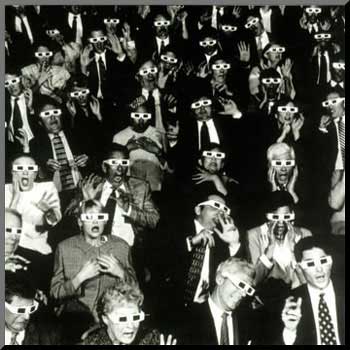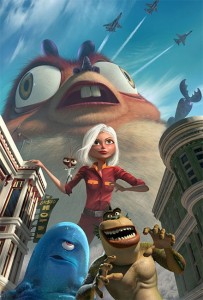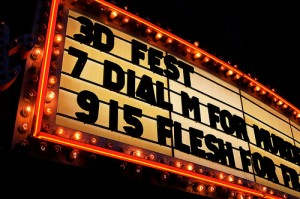Now in glorious 3-D!!!

Before it ever became a fond figment of Americana (akin to drive-ins), 3D movies were an effective means of getting people in seats. Studios and distributors alike have a long history of using primal urges and emotional selling points to get your business, from the first sale of popcorn, Cinerama, and Smell-o-vision to today’s shilling of ultra-combos, IMAX and THX sound.
But using 3D is a trick of the brain; the device makes a user feel something more than what is there. Objects and actions on a screen appear, surreally, somehow more vivid than what one could experience in real life. It activates nerve receptors that stay locked in fascination until the gimmick wears off and common sense returns. 3D movies therefore offer something hyper-real that tricks us into finding more emotion, drama, suspense or comedy in the story than is really there.

still Monsters vs. Aliens, courtesy Dreamworks
This weekend marks the unofficial and incredulous early opening of the big-budget summer movie season with the premiere of DreamWorks’ Monsters vs. Aliens (in 3-D). One could argue that this posited leap-start to the season happened weeks ago with the splashy release of Watchmen, but that opening was to a much smaller niche audience. Opening a kids’ movie in general requires a special finesse and a whole lot of chutzpah marketing.
These days, family movies can be sure-fire money makers and a hard-sell item paradox. Parents want to allow their kids entertainment treats by taking them to High-School Musical 3, but don’t want to sit through Tales of Desperaux or Jonas Brothers in Concert (in 3-D!). Kids want to buy memorabilia and t-shirts from their new favorite movie, but if the story isn’t emotionally solid enough, no one buys the Happy Meal toy. Movie producers and distributors can’t sell more tickets than there are people, but want more money.
 So how do you generate excitement and anticipation for a blockbuster family film when the market is glutted with offerings? Enter 3D or ‘Real D’ technology, for which all of DreamWorks Animation’s movies will now be adapted. Disney made the same point two months prior by showing the first visually-stunning all stop-motion movie Coraline in Disney Digital 3D, which uses the same technology. There is a slate of almost a dozen movies coming out this way in 2009, and lots more on the way next year.
So how do you generate excitement and anticipation for a blockbuster family film when the market is glutted with offerings? Enter 3D or ‘Real D’ technology, for which all of DreamWorks Animation’s movies will now be adapted. Disney made the same point two months prior by showing the first visually-stunning all stop-motion movie Coraline in Disney Digital 3D, which uses the same technology. There is a slate of almost a dozen movies coming out this way in 2009, and lots more on the way next year.
This new technological format was first introduced four years ago, but it wasn’t in widespread use until many theater chains agreed to put the requisite projectors in their multiplexes. With the agreement came a host of planned 3D movies with 2D versions at adjoining theaters. You’ll pay as much as $3 per ticket extra for the 3D screening, an upgrade that comes with hard plastic glasses that allows the magic to happen.
The catch? You have to give them back.
What was once a $6 matinee at Marcus Theatres is now $7 this week. What was once UltraScreen novelty at WestTown now costs an extra $1 – unless you ask for reserved seating which is another $5. At iPic Entertainment, you can get VIP treatment and a small bag of popcorn for $14, perhaps the best evening deal in metro area. Landmark Theatres in Milwaukee (the Oriental and Downer) used to be the most expensive ticket but is now on par with the big box lower-class competitors.
Movies were at one time meant to be an escape for the working class. With the advent of credit card wealth and the addictive crutch of living beyond means, selling a movie only means getting a patron to make the effort to drive out to a suburb and get in the door. At that point, the moviegoer is willing to pay anything to escape from the real world for a while.

photo via flickr by santheo
Modern use of 3D is a technological marvel, a story enhancer, and a marketing ploy. So then, now add to that the idea that 3D is a device – one that pries digits from moviegoers’ bank accounts in exchange for an emotional high.



















Nice article! I’m just glad producers/theatres still offer the non-3D version for Mommies who get wigged-out visual migraines from all that nerve receptor activation.